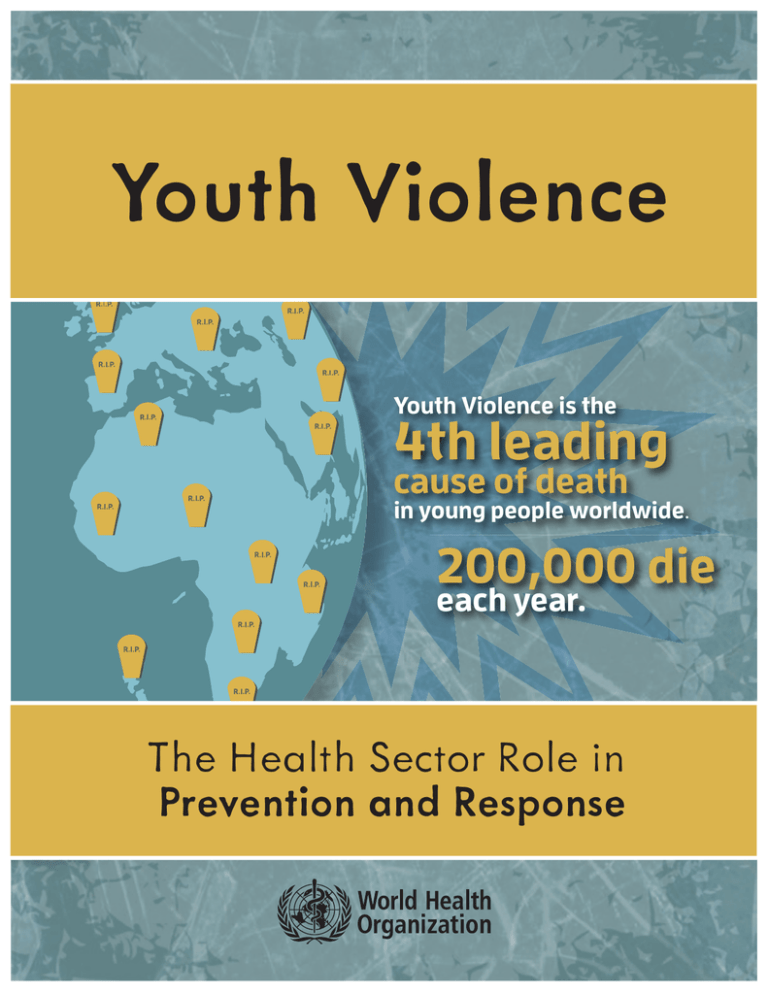
Youth Violence
Youth Violence is the
4th leading
cause of death
in young people worldwide.
200,000 die
each year.
The Health Sector Role in
Prevention and Response
What is youth violence?
Youth violence:
Involves children and
young adults aged 10 to 29
Peaks during late adolescence
and early adulthood
It takes many forms.
Homicide
Homicide
Assault
Assault
Fighting
Bullying
Emotional abuse
Youth violence affects countries unevenly. In some, rates of
youth violence are 100 times higher than in other countries.
Dating violence
Youth violence is widespread.
Worldwide:
4 out of 10
young people
were in a
physical fight in
the last year
1 out of 4
teenagers
were bullied in
the last month
Males are far more likely than females to be killed in youth violence.
83% of victims are male.
Youth Violence has severe consequences.
Some effects of youth violence are visible.
Millions of young people are
admitted to hospitals for
serious injuries each year
as a result of youth violence.
Others are hidden.
1 out of 3 victims of
school violence
never tell anyone about it.
Youth violence has a lasting impact.
Mental health
problems
Poor
performance
in school
Youth violence harms communities.
Fear and anxiety,
loss of social cohesion
Harmful use
of tobacco,
drugs, alcohol
Being a victim of
violence as an
adult — or
committing it
It drains economies.
Health care costs, legal and judicial costs,
lost future earnings, destroyed property
Youth violence is predictable.
Risk factors include problems and behaviours such as:
Struggling
in school
Truancy
and
destructive
behaviour
Having
antisocial
peers
Circumstances like:
• Living in an area with concentrated poverty
• Weak governance and poor rule of law
• Having easy access to alcohol, drugs, and guns
Abusing
alcohol
and drugs
Behaviour
problems
Criminal
activity
Having parents who are:
• Harsh, inconsistent, or disengaged
• Involved in crime
These factors increase the risk of involvement in youth violence —
the more risk factors, the greater the risk.
Youth violence is not inevitable.
We don’t have to wait for it to happen and then act.
We can address the causes and prevent it.
Research has found strategies that work —
potentially anywhere in the world.
We can prevent youth violence.
Punishment alone is not the answer — because
we’re not addressing the root causes.
Interventions at different stages of life can
make a difference — and help stop children
from becoming violent.
During adolescence and
young adulthood
During early childhood
Parenting programmes to
help parents build strong
relationships with their children
Early childhood development
programmes to help
disadvantaged children
keep up with their peers
Life and social skills
development programmes to
help young people build healthy
peer relationships
Schools-based violence
prevention programmes to
prevent bullying
Therapeutic interventions to
help children and teens manage
anger and behaviour problems
Society-level prevention strategies
Policies and programmes to reduce alcohol and drug use
Reducing access to firearms
Urban upgrading and deconcentration of poverty
Community- and problem-oriented policing
The health sector has a vital role in
preventing and responding to youth violence.
Collect data on the impact and costs of youth violence
Start programmes to reduce risk factors for youth violence,
such as behavioural problems, child maltreatment, and the
harmful use of alcohol
Include interventions to prevent youth violence within existing
early childhood development, education, and health programmes
Provide comprehensive health services to survivors, including
emergency care
Collaborate with other sectors to address youth violence, such as
criminal justice, education, and social services
Youth violence is predictable — and preventable.
Together, we can save lives and ensure a safer future
for young people across the globe.
WHO Resources:
• WHO. Violence and Injury Prevention.
• WHO (2015). Preventing youth violence: an overview of the evidence.
• WHO (2014). Global status report on violence prevention 2014.
• WHO (2009). Violence prevention: the evidence.
Design by
www.communicatehealth.com
WHO/NMH/NVI/15.7 © WHO, 2015. All rights reserved

